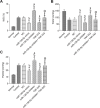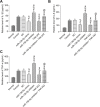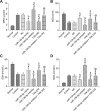miR-139-5p protects septic mice with acute lung injury by inhibiting Toll-like receptor 4/Myeloid differentiation factor 88/Nuclear factor-&mac_kgr;B signaling pathway
- PMID: 33681946
- PMCID: PMC7920407
- DOI: 10.6061/clinics/2021/e2484
miR-139-5p protects septic mice with acute lung injury by inhibiting Toll-like receptor 4/Myeloid differentiation factor 88/Nuclear factor-&mac_kgr;B signaling pathway
Abstract
Objectives: To investigate the role of miR-139-5p and the TLR4/MyD88/NF-κB signaling pathway in acute lung injury in septic mice.
Method: A total of 140 healthy male SPF C57BL/6 mice were divided into seven groups, i.e., Normal, Control, NC, miR-139-5p mimic, miR-139-5p inhibitor, TAK-242, and miR-139-5p inhibitor+TAK-242 groups. The levels of miR-139-5p, proteins related to the TLR4/MyD88/NF-κB signaling pathway (TLR4, MyD88, and p-NF-κB p50), and MPO, SOD, GSH, and MDA in lung tissue were measured. The lung tissue wet-to-dry mass ratio (W/D), arterial oxygen partial pressure (PaO2), and carbon dioxide partial pressure (PaCO2) were measured.
Results: A web-based bioinformatic tool predicted that MyD88 was a target of miR-139-5p, which was verified by a dual luciferase reporter assay. Compared with those in the Normal group, the levels of miR-139-5p, PaO2, SOD, and GSH were significantly lower, while those of TLR4, MyD88, p-NF-κB p50, W/D, PaCO2, IL-1β, TNF-α, IL-6, MPO, and MDA were higher in all other groups. Moreover, compared with their levels in the Control group, these indicators exhibited contrasting results in the miR-139-5p mimic and TAK-242 groups, but were similar in the miR-139-5p inhibitor group. In the miR-139-5p inhibitor+TAK-242 group, acute lung injury, aggravated by miR-139-5p inhibitor, was partially rescued by TAK-242.
Conclusion: miR-139-5p inhibits the TLR4/MyD88/NF-κB signaling pathway to alleviate acute lung injury in septic mice.
Conflict of interest statement
No potential conflict of interest was reported.
Figures





References
-
- Liu W, Liu K, Zhang S, Shan L, Tang J. Tetramethylpyrazine Showed Therapeutic Effects on Sepsis-Induced Acute Lung Injury in Rats by Inhibiting Endoplasmic Reticulum Stress Protein Kinase RNA-Like Endoplasmic Reticulum Kinase (PERK) Signaling-Induced Apoptosis of Pulmonary Microvascular Endothelial Cells. Med Sci Monit. 2018;24:1225–31. doi: 10.12659/MSM.908616. - DOI - PMC - PubMed
MeSH terms
Substances
LinkOut - more resources
Full Text Sources
Other Literature Sources
Medical
Research Materials
Miscellaneous

